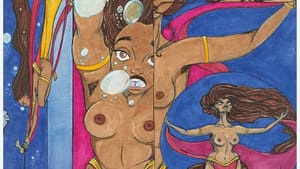Stay in the Loop
BSR publishes on a weekly schedule, with an email newsletter every Wednesday and Thursday morning. There’s no paywall, and subscribing is always free.
Artists at the vanguard
William Way LGBT Community Center presents ‘Black Trans Futuristic’

Our culture is entering a new phase in which trans and gender-nonconforming/nonbinary people are gaining a public voice. Not only are they demanding proper acceptance as equal members of society, but they are speaking out about their unique life experiences as outsiders — and they are insisting that their voices be heard, as in the Black Trans Futuristic art exhibition currently on view at William Way LGBT Community Center.
As usual in the case of any social movement, artists are at the vanguard, sometimes loudly, often eloquently and poignantly expressing to the world at large what it means, in this case, to be trans. The hope is not only to build bridges of understanding but to show how diverse and complex the trans experience is, and that hope is on full display at this William Way group show.
Defying categorization
The exhibition is curated by Wit López (pronouns they/them), a self-described “disabled, gender non-conforming/nonbinary trans performer, visual artist, scholar, and independent curator of African American and Boricua descent.” Given a curator with such a complex perspective, it’s not surprising that the six artists here aren’t easy to categorize.
A variety of media is on display: photography (by Shanel Edwards and Myx Omiya Isa); paintings (by Devyn Farries and Wriply M. Bennet); mixed-media construction (by Jamie Grace Alexander) and found-object installations (by Tahnee Jackson/Essa Terrick).
The paintings of Wriply M. Bennet are perhaps the most immediately eye-catching. With a variety of subjects, addressing a number of different themes, Bennet’s pieces communicate various emotional reactions to a number of issues of trans life. With a bold folk-art style, Bennet’s pieces, while quite direct in their approach, are not easy to interpret — a dichotomy seen throughout the exhibition.
This dichotomy also appeared in the photography of Shanel Edwards. Some of Edwards’s pieces are glimpses of people simply expressing the external manifestation of their identities, sometimes with flamboyance, always with exuberance. A couple of quieter portraits are almost shocking in their intimacy. The subtle and nuanced expressions on the subjects’ faces reveal little, yet speak volumes about the emotionally fraught lives these people have led.
Art as experience
Perhaps the most poignant items in the exhibit are the displays constructed by Tahnee Jackson/Essa Terrick.
Two shelves hold various objects such as lit candles, crystals, rocks, and individual tarot cards — things you would find on a mantlepiece or an altar. Clearly these objects have meaning to someone, representing memories or emotions that together constitute a life. Exact meanings are not important. It’s moving enough to look at these items and to think that these items represent experiences, the sum total of what a person — complex, emotional, enigmatic — has lived.
At heart, that is what all of the artists in Black Trans Futuristic have achieved. They have all, in their own unique ways, offered glimpses into the lives of trans people. And even if they are not always understood, they are at long last being heard.
What, When, Where
Black Trans Futuristic. Curated by Wit López. Through February 22, 2019, at William Way LGBT Community Center, 1315 Spruce Street, Philadelphia. (215) 732-2220 or waygay.org.
Sign up for our newsletter
All of the week's new articles, all in one place. Sign up for the free weekly BSR newsletters, and don't miss a conversation.
 Gary L. Day
Gary L. Day